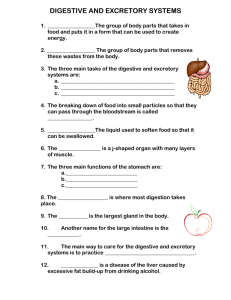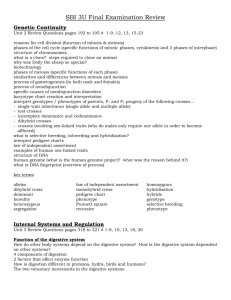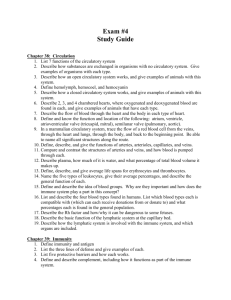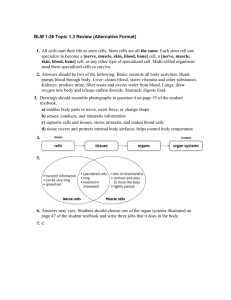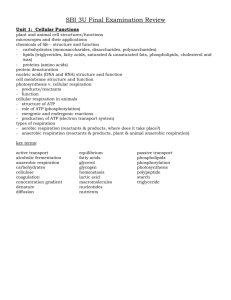UNIT 02.- NUTRITION (Worksheet)_v03
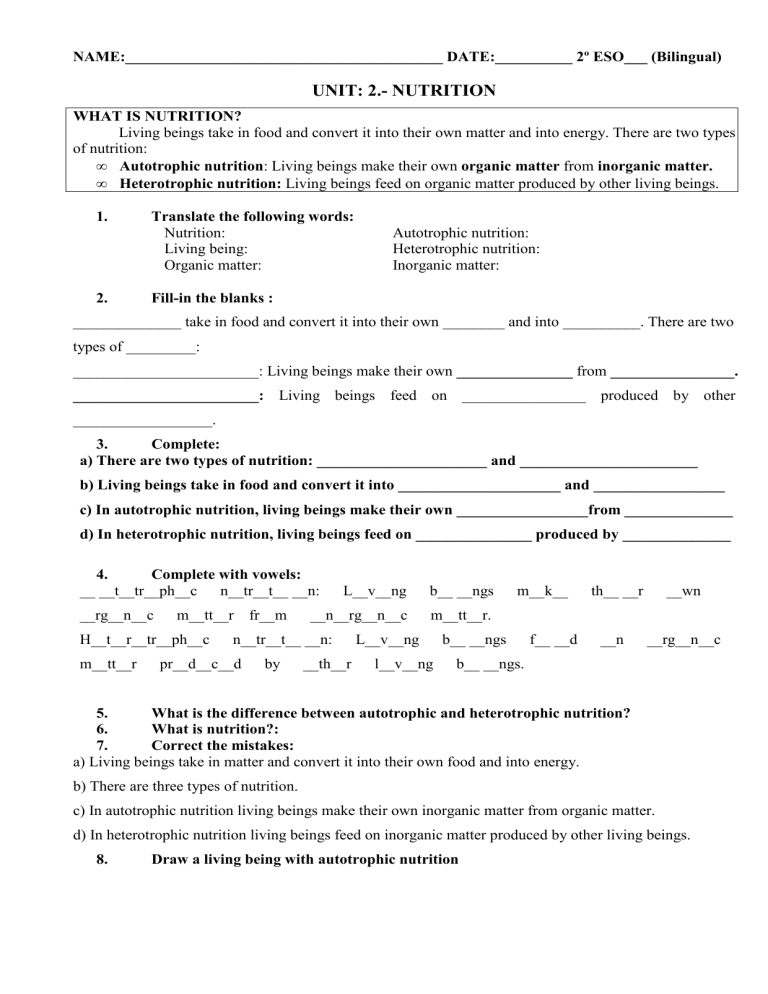
NAME:_________________________________________ DATE:__________ 2º ESO___ (Bilingual)
UNIT: 2.- NUTRITION
WHAT IS NUTRITION?
Living beings take in food and convert it into their own matter and into energy. There are two types of nutrition:
•
Autotrophic nutrition: Living beings make their own organic matter from inorganic matter.
•
Heterotrophic nutrition: Living beings feed on organic matter produced by other living beings.
1.
Translate the following words:
Nutrition: Autotrophic nutrition:
Living being:
Organic matter:
Heterotrophic nutrition:
Inorganic matter:
2.
Fill-in the blanks :
______________ take in food and convert it into their own ________ and into __________. There are two types of _________:
________________________: Living beings make their own _______________ from ________________.
________________________: Living beings feed on ________________ produced by other
__________________.
3.
Complete: a) There are two types of nutrition: ______________________ and _______________________ b) Living beings take in food and convert it into _____________________ and _________________ c) In autotrophic nutrition, living beings make their own _________________from ______________ d) In heterotrophic nutrition, living beings feed on _______________ produced by ______________
4.
Complete with vowels:
__ __t__tr__ph__c n__tr__t__ __n: L__v__ng b__ __ngs m__k__ th__ __r __wn
__rg__n__c m__tt__r fr__m __n__rg__n__c m__tt__r.
H__t__r__tr__ph__c n__tr__t__ __n: L__v__ng b__ __ngs f__ __d __n __rg__n__c m__tt__r pr__d__c__d by __th__r l__v__ng b__ __ngs.
5.
6.
7.
What is the difference between autotrophic and heterotrophic nutrition?
What is nutrition?:
Correct the mistakes: a) Living beings take in matter and convert it into their own food and into energy. b) There are three types of nutrition. c) In autotrophic nutrition living beings make their own inorganic matter from organic matter. d) In heterotrophic nutrition living beings feed on inorganic matter produced by other living beings.
8.
Draw a living being with autotrophic nutrition
WHAT IS THE DIGESTIVE PROCESS?
Digestion includes all the processes which break down food into simple substances which are used for energy, growth and cell repair.
The digestive process in animals has four stages:
•
Ingestion: The intake of food into the body through the mouth.
•
Digestion: The transformation of food into nutrients which the body can absorb.
•
Absorption: It is the passage of nutrients from the digestive system into the blood. The blood carries the nutrients to the cells.
•
Egestion: It is the elimination of waste products from the digestive system
9.
Translate these words:
Ingestion: Absorption:
Digestion: Break down:
Egestion:
Growth:
Mouth:
Blood:
Nutrients:
Body:
Waste products:
Digestive system:
10.
11.
What is the difference between “ingestion” and “digestion:
Correct the mistakes
The digestive process in animals has five stages:
Ingestion: The take of food into the cell through the mouth.
Digestion: The transformation of foot into nutrients which the mouth can absorb.
Absorption: It is the passage of nutrients from the circulatory system into the blood. The hands carries the nutrients to the cells.
Degestion: It is the elimination of food products from the digestive system.
12.
Match the two columns with arrows:
Ingestion It is the elimination of waste products from the digestive system
Digestion
Absorption
Egestion
The intake of food into the body through the mouth
The transformation of food into nutrients which the body can absorb
It is the passage of nutrients from the digestive system into the blood.
13.
Write “T” if the statement is true or “F” if the statement is false. a) Digestion includes all the processes which break down food into simple substances. b) The digestive process in animals and plants has four stages. c) The intake of food into the body through the mouth occurs in the ingestion. d) The transformation of food into nutrients which the body can absorb occurs in the digestion. e) Absorption is the passage of nutrients from the digestive system into the blood. The blood carries the nutrients to the cells. f) Egestion is the elimination of waste products from the circulatory system.
14.
Complete each definition with “ingestion”, “digestion”, “absorption” or “egestion”
______________ : The process by which the products of digestion are transferred into the body's internal environment, enabling them to reach the cells.
_______________: The process of breaking down food into its molecular and chemical components so that these nutrient molecules can cross plasma membranes.
15.
Write these statements in the correct order: a) which the body The transformation Digestion: can absorb. of food into nutrients b) It is the elimination the digestive system. from of waste products Egestion: c) The intake through the mouth. Ingestion: of food into the body d) from the digestive system Absorption: It is the passage into the blood. of nutrients
16.
Label each picture with the appropriate stage of the digestive process:
________________ _________________ __________________ ____________________
17.
Write the words: “ingestion”, “digestion”, “absorption” or “egestion” in its correct place.
WHAT IS THE DIGESTIVE TUBE?
The digestive tube is a tube which begins in the mouth and ends in the anus.
Organs of the digestive tube: in general, the digestive tube is similar in all superior animals rabbit.
Compare the organs in a human and in a
18.
Human:
Rabbit:
Liver:
Pharynx:
Stomach:
Esophagus:
Translate these words:
Digestive tube:
Digestive system:
Tongue:
Rectum:
Gallbladder
Pancreas:
19.
Draw the digestive system (use colours):
20.
What is the order of organs in the digestive system:
Mouth:
Anus:
Large intestine:
Small intestine:
21.
Label this picture:
HOW DO ANIMALS BREATHE?
Animals breathe by inhaling oxygen from the outside, and then exhaling carbon dioxide. There are four types of respiration in animals:
•
Cutaneous respiration: Gas exchange takes place through the skin, which is very thin and moist.
•
Tracheal respiration: Gas exchange takes place through internal tubes or tracheaes.
•
Branchial respiration: Gas exchange takes place through the gills.
•
Pulmonary respiration: Gas exchange takes place in the lungs.
22.
Cutaneous:
Branchial:
Translate these words:
Tracheal:
Pulmonary:
Tracheae:
Oxygen:
Lungs: Skin: Gills:
23.
Complete:
Animals __________ by inhaling ___________ from the ___________, and then exhaling ____________.
There are ______ types of _____________ in animals:
_____________ respiration: Gas exchange takes place through the _____.
_____________ respiration: Gas exchange takes place through the ____________.
_____________ respiration: Gas exchange takes place through the _________.
_____________ respiration: Gas exchange takes place in the __________.
24.
Match the two columns with arrows
Cutaneous respiration lungs
Tracheal respiration
Branchial respiration skin tracheae
Pulmonary respiration
25.
gills
Write bellow of each draw the type or respiration
26.
Look at the human respiratory system and write each word in Spanish together with its respective word in English.
Alvéolos, faringe, epiglotis, laringe, bronquiolos terminales, tráquea, cavidad oral, cartílago, cavidad nasal, bronquio derecho, pulmón izquierdo, fisura oblicua, pulmón derecho, diafragma.
27.
Answer these questions a) What do you think is the type of respiration that most animals use?: b) What do you think is the type of respiration that the biggest animals use?: c) What do you think is the type of respiration that whales use?: d) What do you think is the type of respiration that sharks use?: e) What do you think is the type of respiration that frogs use?: f) What do you think is the type of respiration that flies use?:
WHAT IS THE CIRCULATORY SYSTEM?
The circulatory system consists of:
•
Blood: It is an internal circulatory fluid. Blood carries oxygen and nutrients through out the body and carries waste products away.
•
Blood vessels: They are ducts which carry blood. Arteries carry blood away from the heart and through out the body and veins carry blood from the body back to the heart.
•
Heart: It is an organ like a pump which helps blood to circulate through the blood vessels and through out entire body.
FUNCTIONS OF THE CIRCULATORY SYSTEM: It has two basic functions:
•
It carries nutrients and oxygen to the cells.
•
It removes carbon dioxide and waste products discarded by the metabolism.
TYPES OF CIRCULATORY SYSTEMS: There are two types of circulatory systems:
•
Open circulatory system: the circulating fluid is pumped by the heart, from there, the blood flows through the body cavity, directly to the internal organs.
•
Closed circulatory system: The blood always circulates inside blood vessels pumped by the heart. The vessels deliver blood to body cells and return it to the heart. There are two types of closed circulatory systems:
Simple: the blood passes through the heart once, completing one loop.
Double: The blood passes through the heart twice, completing two loops.
28.
Blood:
Veins:
Once:
29.
Translate these words:
Blood vessels:
Open circulatory system:
Closed circulatory system:
Label the pictures:
Arteries
Heart:
Loop:
30.
a) Label the pictures correctly with: “Open circulatory system” or “Closed circulatory system”
____________________________________ __________________________________ b) Explain your answer:
31.
32.
33.
34.
35.
What are the functions of the circulatory system?:
What are the three important parts of the circulatory system?
What is the blood?:
What are the differences between arteries and veins?:
What are the differences between the “open circulatory system” and the “closed
36.
circulatory system”?:
What are the differences between the “simple closed circulatory system” and the
“double closed circulatory system”?:
WHAT IS EXCRETION?
It is the process of collecting waste products and expelling them outside the body.
Carbon dioxide is expelled by the respiratory system, but others substances are eliminated by the
excretory system.
The excretory system consists of various organs:
•
Kidneys filter the blood and produce urine.
•
Ureters are thin tubes through which the urine leaves the kidneys.
•
The bladder is the place where the urine is stored.
•
Urethra: The urine is expelled from the body through the urethra.
37.
Translate these words:
Circulatory system: Kidneys:
Respiratory system:
Excretory system:
Ureters:
Bladder:
38.
Write the name of each organ in excretory system.
39.
Complete:
The human excretory system is comprised of:
- ____________ produces urine.
- ____________ tubes from kidney to bladder.
- ____________ urine storage organ.
- ____________ organ from bladder to exterior.
40.
Correct the mistakes:
The bladder is the place where the blood is stored.
Urethra:
Urine: body:
Ureters are thin tubes through which the blood leaves bladder.
Urethra: The urine is expelled from the body through the ureters.
Kidneys filter the urine and produce blood.
41.
42.
Kidneys
Ureters
Bladder
Urethra
Draw the human excretory system in the body figure:
Match the two columns with arrows place where the urine is stored. filter the blood. tubes through which the urine leaves the kidneys. urine is expelled from the body to exterior.
43.
Write “T” for true or “F” for false. a) Kidney filter the blood. b) Kidney produces urine. c) Ureters store the urine. d) Ureters are between kidneys and bladder. e) In bladder is stored the urine. f) Bladder is between kidneys and urethra. g) Urethra is between bladder and exterior. h) Excretory system is similar in men and women.
44.
Write the organ names of excretory system in the dog figure (paint with colour the figure):
45.
Write the organ names of excretory system in the zebra:
HOW DO PLANTS CARRY OUT NUTRITION?
Plants are autotrophs. They produce organic matter from inorganic matter, such carbon dioxide, water and mineral salts. Plant nutrition involves five processes:
•
Absorption: water and mineral salts are absorbed by the roots. These inorganic nutrients are called raw sap.
•
Transport of raw sap: The raw sap travels up the stem to the leaves through the xylem vessels.
•
Gas exchange: It takes place in the leaves. Carbon dioxide enters the plant through the stomata.
Oxygen and water evaporates through the stomata too, in the leaves of the plant. Water evaporation is called transpiration.
•
Photosynthesis: It takes place in the chloroplast where chlorophyll is found. Chlorophyll absorbs sunlight to produce energy. Raw sap and carbon dioxide transform into elaborated sap
and oxygen.
•
Transport of elaborated sap: Elaborated sap is transported from the green plant cell to all parts of the plant. This sap, or food, travels through tubes called phloem vessels
•
Respiration. Plants breathe. During respiration, plant leaves take in oxygen from the air and release carbon dioxide.
46.
Raw sap:
Translate these words:
Autotrophs:
Chlorophyll: Sunlight:
Transpiration:
Stomata:
Chloroplast:
Elaborated sap:
Mineral salts:
Inorganic nutrient:
Xylem vessels:
Carbon dioxide:
47.
Complete the coloured rectangles with these words: sunlight, water and mineral salts, carbon dioxide, chlorophyll.
48.
Complete the diagram:
Photosynthesis
chlorophyll leaf
49.
Correct the mistakes: a) Plants are heterotrophy. They produce organic matter from inorganic matter. b) Water and mineral salts are absorbed by the leaf. c) The elaborated sap travels up the stem to the leaves through the xylem vessels. d) Sunlight enters the plant through the stomata.
50.
Complete:
a) Transport of _______________: The raw sap travels up the ________ to the ________ through the
__________________.
b) ____________: water and ______________ are absorbed by the ______. These inorganic nutrients are called ____________. c) ____________________: It takes place in the _________. __________________ enters the plant through the ____________.
51.
Match the two columns with arrows
Transport of raw sap stomata
Absorption chlorophyll
Gas exchange
Photosynthesis xylem vessels raw sap
52.
Complete with vowels:
W__t__r __nd m__n__r__l s__lts __r__ __bs__rb__d by th__ r__ __ts. Th__s__
__n__rg__n__c n__tr__ __nts __r__ c__ll__d r__w s__p.
53.
Put in the correct order these statements: a) mineral salts Water the roots. and are absorbed by b) takes place in the leaves. Gas exchange c) evaporation Water is transpiration. called d) the stomata. through Carbon dioxide the plant enters
54.
55.
Draw a diagram of a plant. Indicate the phases of nutrition foe each part
Observe these drawings a) What does each drawing represent? Day or night? b) Do plant breathe and carry out photosynthesis all day? Explain your answers.

